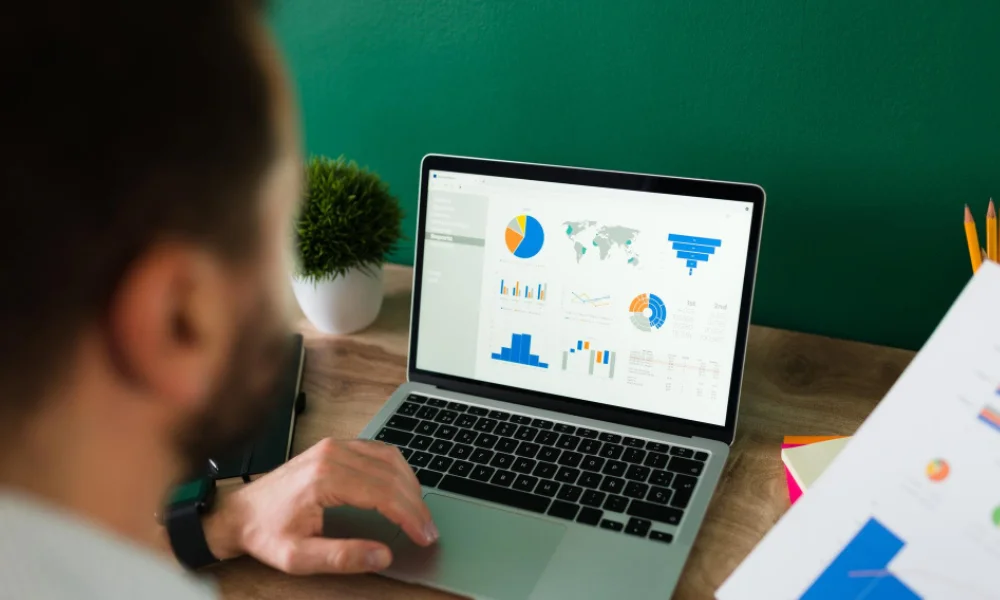On-page SEO optimisation involves enhancing individual web pages to improve their ranking in search engine results. This includes optimising title tags, meta descriptions, content quality, internal linking, and Core Web Vitals to enhance user experience and search visibility.
What is On-Page SEO and Why Does It Matter?
On-page SEO refers to the practice of optimising individual web pages to enhance their search engine rankings and increase organic traffic. This optimisation focuses on both content and HTML source code elements that search engines can crawl and index.
Unlike off-page SEO, which deals with external signals like backlinks, on-page SEO gives you direct control over ranking factors. Every element from your title tags to internal links affects how search engines understand and rank your content.
How Do Title Tags Impact Your Search Rankings?

Title tags serve as the clickable headline in search engine results pages. They represent the most important on-page SEO element that directly influences both rankings and click-through rates from search results.
Search engines display title tags as the primary link text in search results, making them crucial for creating a strong first impression. An optimised title tag should include your target keyword near the beginning while remaining compelling to users.
Optimal Title Tag Length and Structure
Keep title tags between 50 and 60 characters to ensure complete visibility in search results. Place your primary keyword within the first 50 characters whenever possible. This positioning gives maximum SEO value while maintaining readability.
Structure your titles with the most critical information at the beginning. Use separators, such as pipes or dashes, to include your brand name at the end. This format helps users quickly identify your content while preserving keyword prominence.
Keyword Placement in Title Tags
Position your primary keyword naturally within the first half of your title tag. Avoid keyword stuffing by focusing on one main keyword per page. Include modifying words that add context and help target long-tail search queries.
Consider user intent when crafting titles. Commercial intent keywords should emphasise benefits or solutions. Informational queries work better with “how-to” or “guide” formats that promise valuable insights.
Why Are Meta Descriptions Essential for Click-Through Rates?
Meta descriptions function as your page’s elevator pitch in search results. While they don’t directly impact rankings, they significantly influence whether users click on your result over those of your competitors.
Keep meta descriptions under 150 characters to prevent search engines from truncating your message. This character limit ensures your complete message appears in search results across all devices.
Writing Compelling Meta Descriptions
Include your target keyword naturally within the meta description. Search engines often bold-match terms when they align with user queries. This visual emphasis can significantly increase your click-through rates.
Create a sense of urgency or highlight your unique value propositions in the descriptions. Use action words like “discover,” “learn,” or “get” to encourage users to click. Address the searcher’s specific need or pain point directly.
Meta Description Best Practices for 2025
Effective meta description strategies in 2025 align closely with AI, user intent and semantic search. Focus on semantic relevance rather than exact keyword matches. Include related terms that provide context about the value of your content.
Write unique meta descriptions for every page. Duplicate descriptions waste opportunities to target different keywords and user intents. Treat each description as a mini-advertisement for your specific page content.
How Does Content Quality Affect Search Rankings?

Content quality remains the foundation of successful on-page SEO. Search engines prioritise pages that provide comprehensive, accurate, and valuable information that completely satisfies user intent.
High-quality content demonstrates expertise, authoritativeness, and trustworthiness through detailed explanations and supporting evidence. Google’s algorithms evaluate content depth, accuracy, and how well it addresses the searcher’s query.
Content Depth and Topic Coverage
Create comprehensive content that thoroughly covers your topic. Address related subtopics and answer common questions within your main content. This approach helps you naturally rank for multiple related keywords.
Use the inverted pyramid structure, placing the most critical information at the beginning. Follow with supporting details and examples. This organisation caters to both users seeking quick answers and those seeking comprehensive information.
Semantic SEO and Related Keywords
Modern search algorithms understand context and related concepts beyond exact keyword matches. Include synonyms, associated terms, and topically relevant phrases throughout your content naturally.
Target semantic keyword clusters rather than single keywords. This strategy helps your content rank for multiple related queries while providing more comprehensive value to readers.
What Role Do Header Tags Play in SEO?
Header tags (H1, H2, H3) create a logical content hierarchy that helps both users and search engines understand your page structure. They break content into digestible sections while signalling the importance of each topic.
Use only one H1 tag per page as your main heading. Include your primary keyword in the H1 when it flows naturally. Subsequent headers should create a logical outline that guides readers through your content.
Optimising Header Tag Structure
Organise headers in hierarchical order without skipping levels. Follow H2 with H3 subsections when needed. This structure creates a clear content roadmap that search engines can follow easily.
Include related keywords in H2 and H3 tags where appropriate. These headers provide additional context signals to search engines about your content topics while improving user navigation.
Header Tags and Featured Snippets
Well-structured headers increase your chances of earning featured snippets in search results. Use question-based H2 tags followed by concise answers. This format aligns with how users search and how Google extracts snippet content.
Format your headers to match common search queries in your niche. Include numbers, steps, or specific terms that users frequently search for when seeking information.
How Can Internal Linking Boost Your SEO Performance?
Internal linking connects your content pieces while distributing page authority throughout your site. Strategic internal links help search engines discover and understand the relationship between your pages.
Create contextual internal links that offer readers additional value. Link to relevant supporting content that expands on topics mentioned in your current page. This practice improves user engagement and session duration.
Internal Linking Strategy and Anchor Text
Use descriptive anchor text that tells users what they’ll find on the linked page. Avoid generic phrases like “click here” or “read more.” Include relevant keywords in anchor text naturally without over-optimisation.
Link to your most essential pages from multiple relevant locations throughout your site. This internal link equity helps boost the authority of priority pages while creating a clear site architecture.
Topic Clusters and Content Hubs
Organise your content into topic clusters with pillar pages linking to related subtopic pages. This structure demonstrates topical authority while making it easier for search engines to understand your areas of expertise.
Create comprehensive hub pages that link to detailed subtopic content. These pillar pages should provide broad overviews while linking to specific, detailed articles that dive deeper into individual aspects.
Why is URL Structure Important for SEO?
Clean, descriptive URLs help both users and search engines understand your page content before visiting. Short, keyword-rich URLs perform better in search results and are more likely to be shared.
Include your target keyword in the URL slug when possible. Remove unnecessary words like “the,” “and,” or “of” to keep URLs concise and clear. Use hyphens to separate words for better readability.
URL Optimisation Best Practices
Keep URLs under 100 characters for optimal performance. Longer URLs may be truncated in search results, making them more difficult for users to remember and share manually.
Use lowercase letters consistently in URLs. Avoid special characters, numbers, or symbols that don’t add semantic value. Create a logical folder structure that reflects your site’s content hierarchy.
URL Structure and Site Architecture
Design URL structures that scale with your content growth. Use consistent patterns across similar page types. This organisation helps users navigate your site intuitively while providing clear signals to search engines.
Implement breadcrumb navigation that matches your URL structure. This dual approach reinforces your site hierarchy while providing additional internal linking opportunities throughout your content.
How Do Core Web Vitals Influence Search Rankings?

Core Web Vitals include Largest Contentful Paint (LCP) under 2.5 seconds, Interaction to Next Paint (INP) under 200 milliseconds, and Cumulative Layout Shift (CLS) under 0.1. These metrics measure loading performance, interactivity, and visual stability.
Sites that meet Core Web Vitals benchmarks experience a 24% reduction in bounce rates, while businesses that improve LCP by 0.1 seconds see a 10% increase in conversions. These improvements directly impact both user satisfaction and business outcomes.
Largest Contentful Paint Optimisation
LCP measures how quickly your main content loads. Optimise images by using modern formats like WebP and implementing responsive images with proper sizing. Minimise server response times by implementing effective hosting and caching strategies.
Prioritise loading critical above-the-fold content first. Remove unnecessary plugins or scripts that delay initial rendering. Use content delivery networks to serve resources from locations closer to your users.
Interaction with Next Paint Enhancement
INP measures how quickly your page responds to user interactions, such as clicks and taps. Reduce JavaScript execution time by splitting large scripts and loading non-critical code asynchronously.
Optimise third-party scripts to prevent blocking user interactions. Utilise web workers for computationally intensive tasks. Implement efficient event handlers that don’t delay page responsiveness during user interactions.
Cumulative Layout Shift Prevention
CLS measures unexpected layout shifts that occur during page loading. Set explicit dimensions for images, videos, and other media elements to ensure optimal display and alignment. Reserve space for dynamically loaded content to prevent content jumping.
Avoid inserting new content above existing content after initial load. Use CSS aspect ratios for responsive media elements to ensure optimal display. Test your pages across different devices to identify potential layout stability issues.
What Image Optimisation Techniques Improve SEO?
Image optimisation reduces page load times while providing additional opportunities to rank in image search results. Properly optimised images contribute to improved Core Web Vitals scores and a more enhanced user experience.
Use descriptive, keyword-rich file names before uploading images. Include relevant keywords in alt text to help search engines understand image content. This practice also improves accessibility for visually impaired users.
Image Format and Compression
Select the appropriate image formats based on the content type. Use WebP for photographs and complex images. SVG works best for simple graphics and icons. Implement responsive images that serve different sizes based on device capabilities.
Compress images without sacrificing visual quality. Utilise tools that optimise file sizes while maintaining a crisp appearance. Implement lazy loading for images below the fold to improve initial page load speeds.
Alt Text and Image SEO
Write descriptive alt text that concisely explains the image content. Include relevant keywords naturally without keyword stuffing. Alt text should make sense when read aloud by screen readers.
Use structured data markup for important images, such as product photos or infographics, to enhance their visibility and relevance. This additional context helps search engines understand the relevance of images and may enable rich snippets in search results.
How Does Page Loading Speed Affect Rankings?
Page speed has a direct impact on user experience and search rankings. Faster loading, quicker interactivity, and stable layouts mean happier visitors, lower bounce rates, and higher conversions. Google rewards fast-loading sites with better search positions.
Optimise your hosting environment by selecting servers with sufficient resources and optimal configuration. Enable compression, leverage browser caching, and minimise HTTP requests to significantly reduce loading times.
Technical Speed Optimisation
Minify CSS, JavaScript, and HTML files to reduce file sizes. Remove unnecessary code comments and whitespace that add bulk without functionality. Combine multiple files when possible to reduce server requests.
Implement critical CSS inline for above-the-fold content. Load non-critical styles asynchronously to prevent render blocking. Utilise efficient caching strategies that strike a balance between freshness and performance benefits.
Mobile Page Speed Optimisation
Prioritise mobile page speed, as Google now uses mobile-first indexing. Test your pages on actual mobile devices and slower network connections. Optimise for 3G speeds to ensure accessibility across all user conditions.
Reduce mobile-specific elements that slow loading. Minimise pop-up usage and heavy animations on mobile devices. Focus on essential functionality and content for mobile users.
Why is Mobile Optimisation Critical for SEO Success?
Mobile optimisation is crucial, as Google now uses mobile-first indexing for all websites. Your mobile version determines how search engines crawl, index, and rank your content across all devices.
Implement a responsive design that seamlessly adapts to various screen sizes. Ensure all content and functionality available on desktop remains accessible on mobile devices. Test interactive elements, such as buttons and forms, across various mobile platforms.
Mobile User Experience Factors
Design touch-friendly interfaces with adequately sized buttons and links. Maintain sufficient spacing between clickable elements to prevent accidental taps. Optimise font sizes for mobile readability without requiring users to zoom.
Streamline mobile navigation with clear menu structures. Implement search functionality that works efficiently on smaller screens. Prioritise essential content and features for mobile users who typically browse with a specific intent.
Mobile Core Web Vitals
Focus primarily on mobile Core Web Vitals since they often lag behind desktop performance. Optimise mobile images and reduce heavy resources that significantly impact mobile loading speeds.
Test mobile interactivity thoroughly across different devices and operating systems. Mobile users expect immediate responses to touches and swipes. Delays in mobile interactions create impoverished user experiences.
How Should You Optimise Content for User Intent?
Understanding and matching user intent is crucial for on-page SEO success. Search engines prioritise content that directly addresses what users seek when they make specific queries.
For example, if your goal is to improve your B2B marketing strategy, using the right tools can help you align content with user intent more effectively. Tools that focus on keyword research, competitive analysis, and content performance can ensure your pages answer exactly what users are searching for. You can explore some of the best B2B SEO tools here to enhance your content strategy and meet user expectations.
Search Intent Types and Content Strategy
Informational intent necessitates comprehensive, educational content that thoroughly answers questions. Use precise explanations, examples, and step-by-step guidance to structure content with headers that address common, related questions.
Commercial and transactional intent needs content focused on solutions, benefits, and action steps. Include product comparisons, pricing information, and clear calls to action that guide users toward informed purchase decisions.
Content Freshness and Updates
Keep content current with regular updates that reflect industry changes and new information. Search engines favour fresh, accurate content over outdated information that may mislead users.
Monitor your content performance and update sections that become obsolete. Add new information, examples, and insights that maintain your content’s competitive advantage over Time.
What Technical SEO Elements Enhance On-Page Optimisation?
Technical SEO elements work behind the scenes to help search engines crawl, understand, and index your content effectively. These foundational elements support all other on-page optimisation efforts.
Implement proper schema markup to provide additional context about your content. Utilise relevant structured data types that enable search engines to display rich snippets and enhanced search results.
Schema Markup and Structured Data
Add schema markup for articles, products, reviews, and other relevant content types. This structured data helps search engines understand the context of your content and may trigger rich snippet displays.
Test your schema implementation using Google’s Rich Results Test tool. Ensure that markup validates correctly and provides meaningful information that enhances the appearance of your search results.
Canonical Tags and Duplicate Content
Implement canonical tags to prevent duplicate content issues when similar content exists across multiple URLs. Point canonical tags to the preferred version of your content to consolidate ranking signals.
Address thin or duplicate content that provides little unique value. Consolidate similar pages or add substantial, unique content that clearly differentiates each page.
How Can You Measure On-Page SEO Success?

Track your on-page SEO performance using Google Search Console and analytics tools. Monitor keyword rankings, click-through rates, and changes in organic traffic following optimisation efforts.
The Core Web Vitals report displays URL performance categorised by status (Poor, Needs Improvement, Good), metric type, and URL group. Use this data to prioritise pages that need technical enhancements.
Key Performance Indicators
Monitor organic traffic growth to pages you’ve optimised. Track improvements in average search position for target keywords. Measure click-through rates from search results to identify titles and descriptions that need refinement.
Analyse user engagement metrics, such as bounce rate, session duration, and pages per session. These signals indicate whether your optimised content effectively satisfies user intent.
Ongoing Optimisation and Testing
Conduct regular SEO audits to identify new optimisation opportunities. Test different title variations and meta descriptions to improve click-through rates. Use A/B testing for critical pages when possible.
Stay updated with Google algorithm changes and adjust strategies accordingly. Search engines now utilise advanced AI systems and operate across multiple platforms where users discover content. Adapt your optimisation approach to meet the evolving requirements of the search landscape.
Conclusion
On-page SEO optimisation requires a holistic approach that balances technical excellence with user-focused content creation. Success comes from implementing comprehensive strategies that address every element from title tags to Core Web Vitals performance. For those looking to ensure their website meets all technical and content standards, following a complete SEO audit checklist can be incredibly helpful.
The key to effective on-page SEO lies in understanding that search engines prioritise user satisfaction above all else. Focus on creating valuable, fast-loading content that genuinely helps your audience, while consistently following technical best practices.










